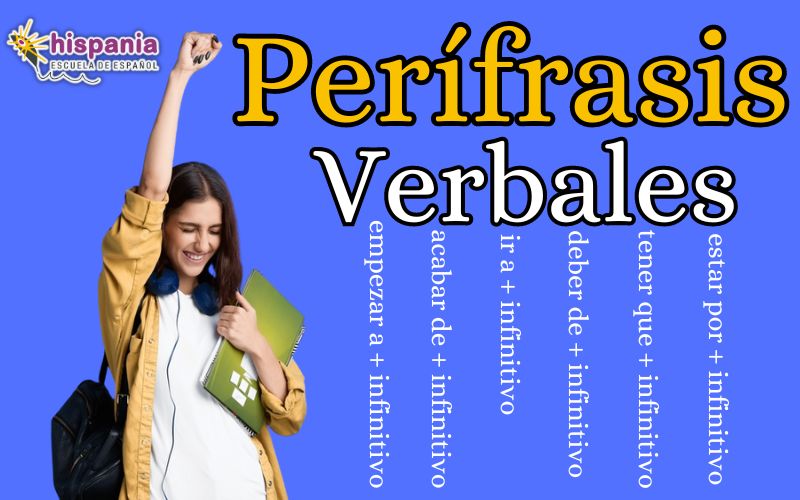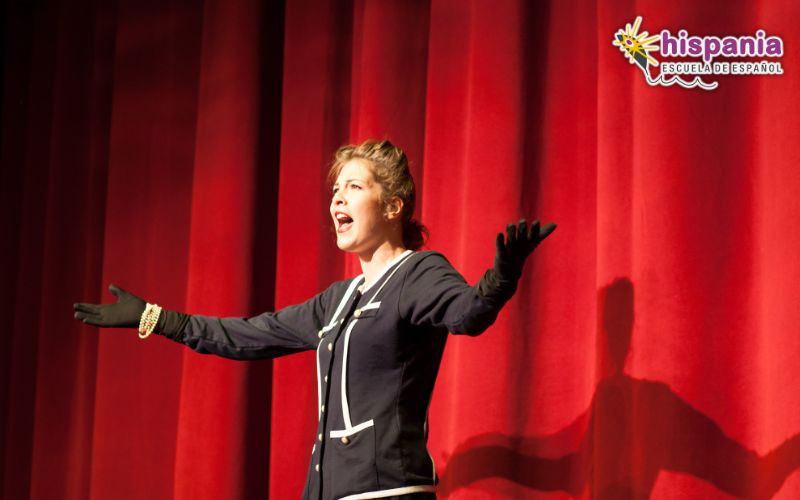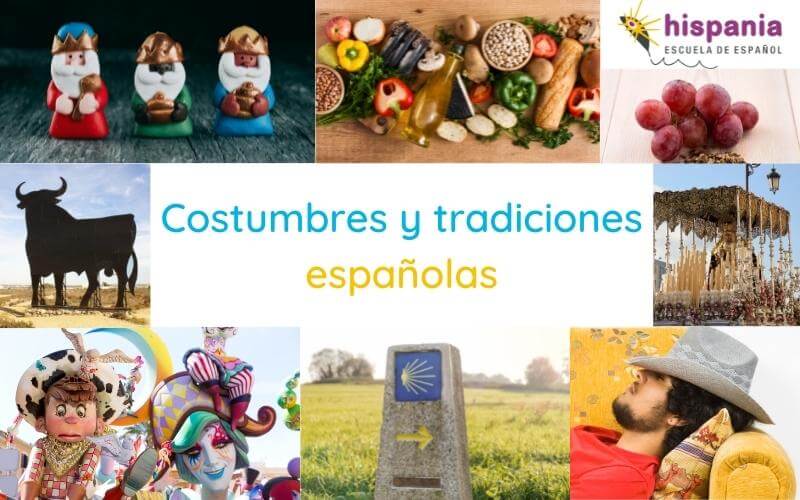
Spanish Traditions. Let us tell you all about them!
Interested in finding out more about customs and traditions from Spain?
We’re going to dive right into it during this article. By the end of the article, you’ll know all there is to know about Spanish culture and you’ll know us Spaniards much better. 😁
¡Empezamos!
Spanish cuisine
There are many important parts that make up Spanish culture.
We are going to start with food.
La Spanish cuisine it is quite varied.
You’ll find that whether its the south, north, centre or coast here in Spain, each area boasts different and delicious dishes.
But if something were to define Spanish cuisine, it would have to be the Mediterranean diet.
Mediterranean diet
La Mediterranean diet comes from the regions found on the Mediterranean Sea: Spain, Italy, Greece, Cyprus…
Did you know that it is considered as one of the healthiest diets in the world?
Let me tell you why.
What is the Mediterranean diet?
It's so healthy for foods that compose it.
The main foods in the diet include a variety of vegetables, fruits, meats, legumes, nuts, fish and dairy.
We are talking about tomato, onion, tune, goats cheese and rocket salads!
Oh, and don't forget to season it with olive oil, our main condiment. 😋
It is what we call in Spanish a typically Spanish to use use the olive oil for cooking.

Meal times in Spain
So what time do people eat in Spain?
In Spain we have four main meals a day.
Does it seem like a lot?
You’re starting to get an idea of how much we love our food here in Spain. We’re… ¡Bastante comilones! 😄
Although, truthfully, many people only eat 3 meals a day.
Desayuno - What time is breakfast in Spain?
El breakfast in spain es from 7.00 to 8.00 in the morningjust before going to work.
¿Te apetece un café con leche y unas tostadas de tomate con aceite?
Sounds delicious, right?
Almuerzo - Mid-morning snack in Spain
For many Spaniards, it is common to take a break in the middle of the morning, between 10.00:11.00 and XNUMX:XNUMX and refuel with some fruit, nuts or a sandwich.
A few people even a few people who eat a bocadillo sandwich!
Do you know what the difference is between bocadillo and sandwich?
It's just the bread...
With a sandwich the bread is square.
And with a bocadillo the bread is baguette bread.
Comida - Lunch in Spain
Eating time in Spain is usually from 14.00:15.00 to XNUMX:XNUMX.
But it depends on your work schedule.
There are even people who take lunch at 15:XNUMX.
Merienda - Snack time in Spain
Late in the afternoon, when leaving work or class, many Spaniards like to have something to eat: fruit, a tostada, some nuts...
¿When is snack-time in Spain??
It's usually around 17:18 or XNUMX:XNUMX pm.
I remember, when I was younger, I loved coming home from school and having a snack and a glass of milk with chocolate chip cookies.
It was my reward after a long day of study💪.
Cena - What time is dinner in Spain??
La Dinner time es between the 21.00 and the 22.00.
And yes I know you're thinking, we ate very late and it is one of the weirdest habits we have.
I have tried many times to eat dinner earlier and I really can't.
Old habits are very hard to change.
Sobremesa - What is it?
Sobremesa is the time spent resting at the table after eating lunch o dinner.
At this time it is common to talk to your tablemates about how the day went with a coffee in hand. very important in the culture of spain.
In our holidays o non-work, the desktop can be extended up to an hour... Or more!
You already know how much we love to talk. 😁
Chit-chatting at the table or go to canes with friends are some of the Spanish customs more enjoyable.
You’ll soon see for yourself!
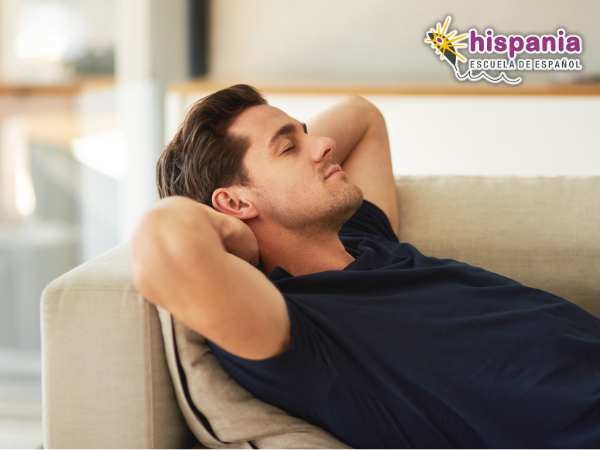
The Spanish siesta
So what happens after sobremesa?
Well... una buena siesta.
La spanish tradition by excellence.
Siesta time in Spain
Between 15:16 and XNUMX:XNUMX, Spaniards take the opportunity to relax on the sofa at home, watch a little TV or read a few pages of a book and, suddenly, fall asleep.
It's something that cannot be avoided. Anyone at home during this time is at high risk of taking a Spanish siesta.
How long does it last?
Usually not very long, ideally between 30 or 40 minutes.
Although, once you've shut your eyes, it can be a little difficult to get them open again and may take up to an hour. 😴
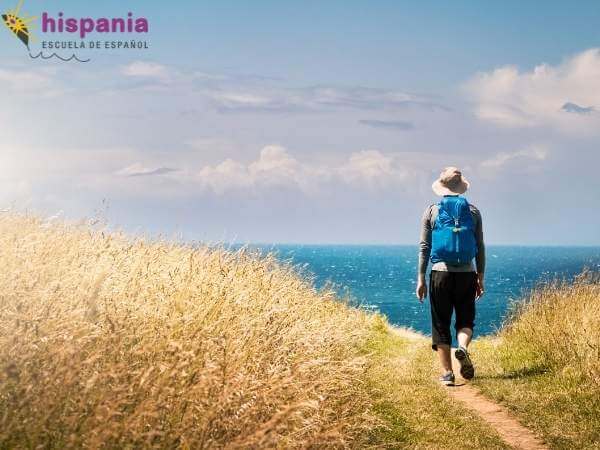
The road to Santiago
From talk about food and naps, It's time for a little activity and one of the traditions in Spain prettiest we have: The road to Santiago.
The road to Santiago is a pilgrimage route to the Cathedral of Santiago of Compostela, in Galicia.
You can start the journey almost anywhere, although the most common route is in the north.
People of all ages come from all over the world to complete the pilgrimage on foot. They sleep in hostels and meet new people along the way.
Everyone who completes it, feel completely delighted by the end and say that it’s changed their lives.
How about you? Would you dare to do this challenge?
The Camino de Santiago: routes
Some of the routes of the Camino de Santiago
- El Camino Francés : This is the most popular route. It starts at the French Pyrenees and goes through the entire north of Spain until it reaches Galicia.
- Vía de la Plata: This route starts in Andalusia and goes through Extremadura before arriving in Galicia.
- Camino Primitivo: Connecting Oviedo to Santiago, this route is shorter than the previous ones.
- Camino de Invierno: : This route starts in the flatlands in the centre of Spain.
- Camino Portugués: Another interesting route that beings outside of Spain, in Portugal.
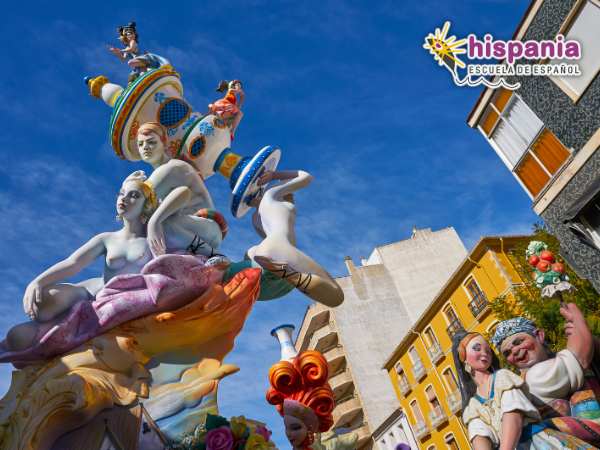
Valencian Fallas
Valencia it has many interesting things to see and do.
The Valencian Fallas is one of the most important things.
I am not exaggerating when I say that it is one of the most popular Spanish celebrations.
It has become a global event.
Each year more and more people come from all over the world to experience Las Fallas.
When are the Valencian Fallas?
The Valencian Fallas take place between the 15th and 19th of March.
However some celebrations start before the 15th like la mascletà o street parties.
The 15th of March is the official start date of the Fallas because it’s when the fallas and the ninots are displayed on the streets.
The 19th is San José, a bank-holiday where the Fallas are set on fire and burnt , marking the end of the celebration.
What are the Valencian Fallas?
The Fallas are sculptures made out of the previously mentioned ninots.
The ninots are dolls made of cardboard, cork, wood and other materials.
The fallas are usually satirical: they often deal with some current issue in a humorous light, and make fun of politicians or criticize the society in which we live.
Some, however, are very experimentaland considered contemporary art.
Others are simply enormous y beautiful, trying to impact people through their breathtaking beauty and colours.
El 19th of March they set them alight , referring to the ancient carpenters who burned wood in the street as a ritual to usher in spring.
Las Fallas are, without a doubt, one of the most interesting celebrations in Spain and should not be missed.
Sanfermines
We continue with more parties and traditions from Spain.
You like this topic a lot, am I right?
The Parties of San Fermin in Pamplona they are the most famous in Spain and attract thousands of tourists from all over the world every year.
The celebration takes place between the 7th and the 14th of July.
Have you ever seen people wearing white clothes and a red scarf?
well, this is the traditional clothing for San Fermin.
Bull run in San Fermin
The main event of this celebration is the Encierros.
People run through very narrow streets … chased by bulls!
Only the bravest take part in Los Encierros since, as you can imagine, it can be quite dangerous.
The Encierros bull chase ends in a bullring, where people continue being chased and try to dodge the bulls in the larger area.
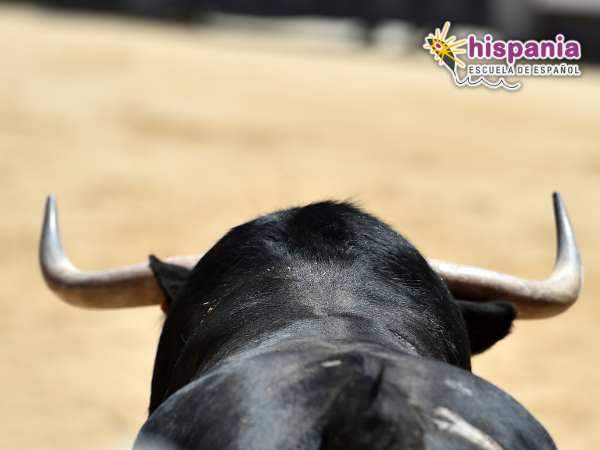
Bullfighting
These movies are bullfighting parties have a long history and is one of the typical things in Spain.
It’s not just Sanfermines.
Practically throughout the year you will have the opportunity to see bullfights.
What are bullfights?
Bullfighting takes place in a bullfighting ring.
There is a bullfighter (un torero) dressed in a traditional costume, "el traje de luces". The "torero" fights the bull and performs a series of actions called "lidiar al toro".
During a bullfight there are usually six brave bulls . It is common for there to be three bullfighters; each bullfighter will fight two bulls alongside their respective group which is made up of banderilleros and picadores.
There are also bullfights which is when the fight of the bulls is done on horseback.
People do not participate in bullfights, like with the Encierros in San Fermin. Instead, people enjoy the show as a spectator.
What time do the bullfights start?
There is various schedules.
En March fights usually start at 17:XNUMX in the evening.
After this, during in August, the schedule is delayed by two hours to 19:XNUMX PM.
In autumn the schedule is brought forward again to 18:XNUMX PM.
The bullfighting season starts in February and ends in October.
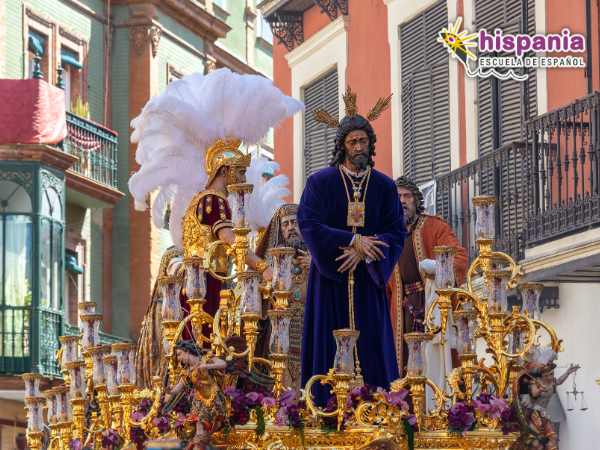
Semana Santa in Spain
Semana Santa is a religious celebration which takes place throughout the entire country.
When it's holy week?
La Semana Santa in Spain is usually during April, although occasionally it's in March. It is not always on the same day of the month.
The days in which it takes place are the following:
- Palm Sunday.
- Easter Monday.
- Holy Tuesday.
- Holy Wednesday.
- Holy Thursday.
- Good Friday.
- Holy Saturday.
- Easter Sunday.
El Holy Thursday and Good Friday They are national holidays.
On the the region of Valencia and in Catalonia . Easter monday. 😁
Easter parades
During Easter people parade through the streetsto demonstrate their religious belief.
People carry all sorts of objects that represent the Christian faith as well as, images and figurines that represent Jesus and other important biblical figures.
The people that carry such objects are called "costaleros".
The parades are led by "cofradías".
Those participating in the parades typically wear a tunic with a cape and hood.
There is Parades take place throughout the whole of Spain, although where they have more presence is in Andalusia.
Another big and important celebration in this region is the April Fair or "Feria de Abril" in Sevilla .
If you like flamenco, you will really enjoy this festival.
Music during Semana Santa
Music that accompanies the parades is called "marchas".
The music is taken from funerals and represents the sadness and solemnity of Christ's death.
To get these emotions, many use the drums and bass drum.
Although other instruments are also used such as "la corneta, la heráldica" and "la carraca".
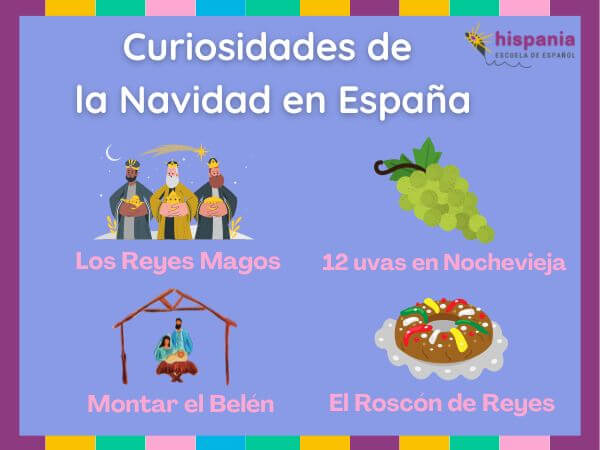
Interesting facts about Christmas in Spain
Finally, we are going to talk about most peoples favourite time of the year... Christmas... la Navidad.
Let me tell you the main traditions during Christmas in Spain.
How is Christmas celebrated in Spain?
Christmas has a special charm that fascinates everyone, don't you think?
The streets are lit up, the Christmas trees, the gifts, the Christmas carols, the Christmas markets...
There are quite a few important days during Christmas in Valencia and Spain. Let's take a look at them now:
- December 22nd: Lotería de Navidad a lottery where a large sum of money is awarded to the winners.
- December 24th: is Nochebuena / Christmas Eve on this day families often gather at home to enjoy a large meal together. Those who are really in the Christmas spirit tend to sing carols .
- December 25th: Día de Navidad / Christmas day. Families get back together for the big Christmas feast.
- December 28th: Día de los Inocentes . Are you a bit of a clown? Well, take the opportunity to play a prank on your friends and family on this day. 😁
- December 31st: Nochevieja / New Years Eve which is officially the last day of the year. Let's see if you can guess what we do on this day? Another big meal with our loved ones and friends. It's a night filled with partying, dancing and joy.
- January 1st: is Año Nuevo / New Years Day. People usually spend this day resting and enjoying time with family. But, it's always possible to squeeze in another good feast.
- 6th of January: Día de Reyes / Kings Day. I will tell you about this later.
So, as you can see, we like to spend time with the family here in Spain during Christmas, and eat… eat A LOT.
What do we usually eat?
Well, the traditionally we eat are seafood and lamb, and for sweet treats we like to eat "turrones" a type of nougat and "polvorones" a shortbread.
It's pretty normal to gain a few pounds here in Spain during the Christmas period. 😅
How about drinks?
At the end of the meal, we typically like to toast with cider, cava or champagne and wish all the guests at the table a Happy Holiday.
The Christmas Nativity
There is also time for Christmas arts and crafts.
Es Typically in Spain , families put together the nativity scene in the living rooms of their houses.
The nativity scene represents the birth of Jesus in the city of Bethlehem.
The figures that must be included are:
- The Virgin Mary.
- Saint Joseph.
- The three wise men.
- Jesus.
- The shepherds and the sheep.
- The manger.
- Other animals such as donkeys and oxen.
- Shooting Star.
- Moss.
Nativity scenes come in all shapes and sizes.
Here in Valencia, they often put on big and impressive nativity displays.
Eating 12 grapes on New Years Eve
Another New Years ancient traditions and more important is to eat 12 grapes on New Years Eve.
You have to eat a grape for each chime of the bell as the clock strikes 00pm on January the 1st.
You have to eat twelve grapes in twelve seconds!
Imagine everyone's face with the 12 grapes stuffed into their mouths, it's hilarious. ????
However, it is one of customs in Spain with more roots.
Why do we eat XNUMX grapes as the clock strikes XNUMXpm??
Completing this tradition brings good luck, meaning you'll enter into the New Year with the right foot forward.
Another New Years Spanish superstition is that wearing red underwear brings good luck too!
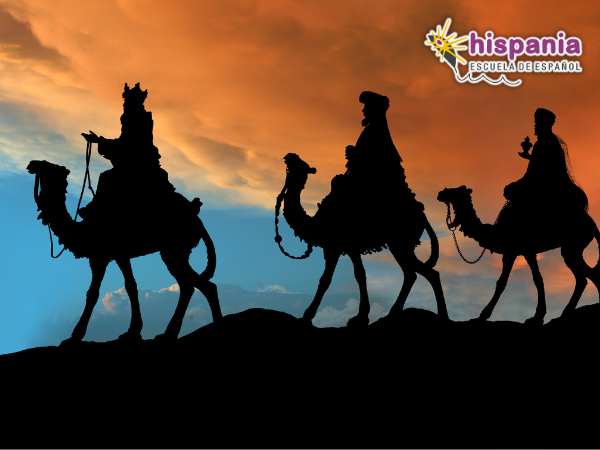
Los Reyes Magos - The Three Wise Men
I have mentioned before that the 6th of January is a day dedicated to the Wise Men.
The names of the wise men are Melchor, Gaspar and Baltasar. You'll definitely have seen them before. They usually ride camels, wear a crown and very colorful clothes.
They really do look like wizards from Disney.
According to Matthew's Gospel, the 3 wise men went from the East to Bethlehem to honour the birth of Jesus of Nazareth, by giving him valuable gifts such as, gold, frankincense and myrrh.
Day on the day of the Wise Men
Did you know that the Wise Men still come to Spain and leave gifts for the children?
The January 5 is celebrated the arrival of the wise men with cavalcades across the country, throwing candy at everyone.
It's a really fun and special moment to be part of. If you want to experience something traditionally Spanish. watching one of these parades is a must do!
On the 5th January during the evening, the children leave some food and water for the Kings and their camels, as a Thank you for bringing you gifts from so far away.
Traditions on the day of the Wise Men
The 6th of January is the most popular day amongst Spanish children.
At last they receive their long-awaited royal gifts.
And how do kings know what each child wants?
Because the the children write a letter to the Wise Men telling them what gifts they want.
Roscón de Reyes - The Wise Men cake
Of course, we can't forget the classic Wise Men day dessert: el Roscón de Reyes.
It is a sweet bun that has chocolate or cream inside, garnished with candied fruit.
Inside there are two surprises: a figurine of a king and a bean.
If you have the king in your piece of roscón, congratulations!
It means that you will have good luck and everyone satat the table should treat you like a king. ????
On the other hand, if you get the bean you have to pay for the roscón.
What an exciting moment?
Choose your piece of Roscón wisely. 😁
As you see, lChristmas is very important in Spain It is very important and is celebrated as a family for many days.
It is a very special occasion in our school: Hispania, escuela de español.
At Christmas time, in our Spanish courses We do many activities related to Christmas:
- We give out awards to students who enter in the Christmas lottery.
- We eat grapes on New Year's Eve.
- We sing carols.
If you come to our school, you'll learn Spanish in Valencia alongside great company and you'll never feel alone.
Take a look at the Christmas spirit here at Hispania, escuela de español in the following video.
¡Un fuerte abrazo!
Article written by Carlos Martínez for Hispania, escuela de español
More articles

